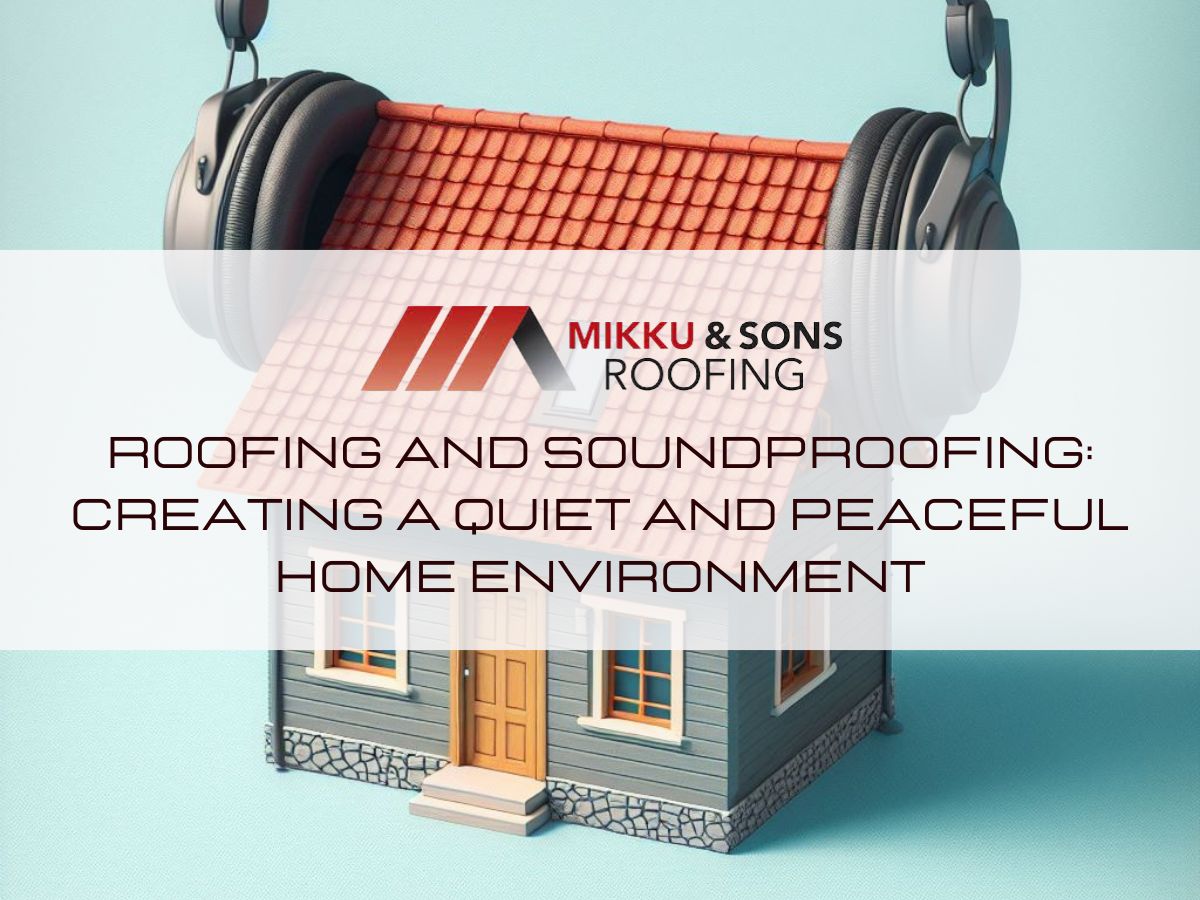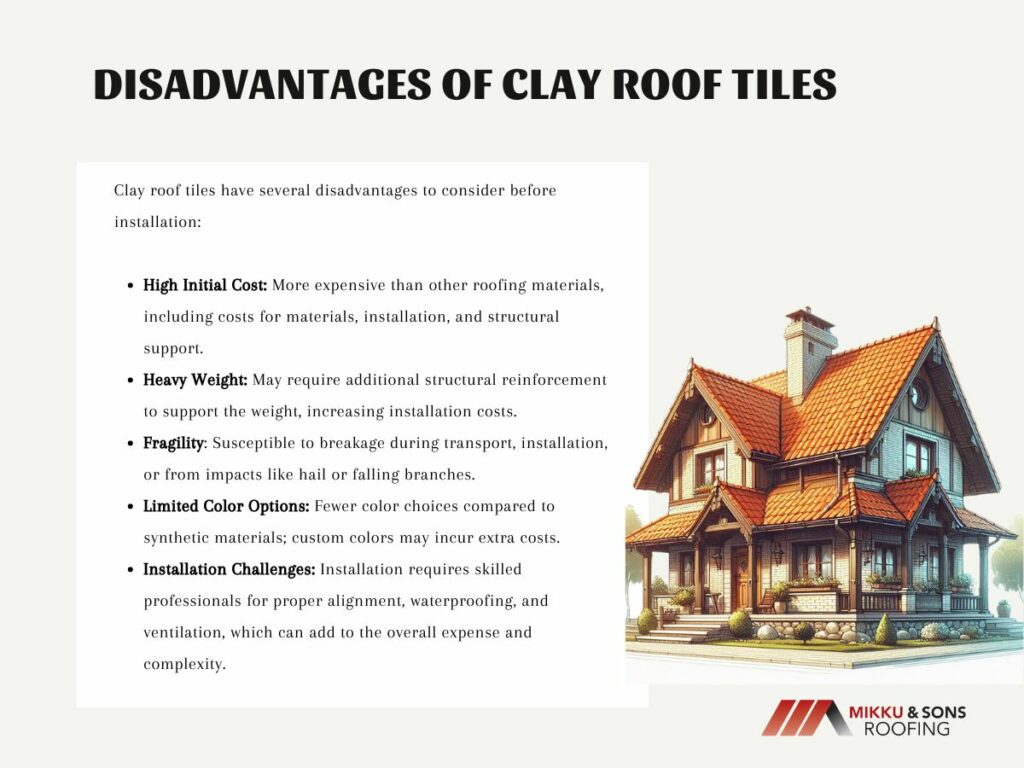

Clay roof tiles are durable roofing materials made from fired natural clay. They come in various shapes and colors, offering a timeless aesthetic appeal.
In this comprehensive exploration, we delve into the realm of clay roof tiles, uncovering their diverse advantages, potential limitations, and crucial considerations for homeowners. From their enduring elegance and resilience to factors such as costs, weight, and maintenance requirements, this overview guides through the complexities of clay tile roofing.
By carefully weighing both the positives and negatives and considering factors like finances, regulations, and warranties, homeowners can confidently embark on the journey of selecting the optimal roofing solution with clarity and assurance. Let's look at the advantages & disadvantages of clay roof tiles.
Clay roof tiles have long been cherished for their array of benefits, making them a preferred roofing material for homeowners worldwide. Let's explore some of the significant advantages of clay roof tiles:

Clay roof tiles are celebrated for their outstanding durability. Crafted from natural clay materials and subjected to high-temperature firing, they withstand harsh weather conditions such as heavy rain, strong winds, and extreme temperatures. When installed and maintained correctly, clay tiles can endure for many decades, often surpassing the lifespan of alternative roofing materials.
A standout feature of clay roof tiles is their enduring aesthetic allure. Available in a diverse range of colors, shapes, and textures, clay tiles imbue any architectural style with character and elegance, from traditional to contemporary. Their rich earth tones and textured surfaces create a welcoming and distinctive appearance, enhancing the overall curb appeal of any home.
Clay roof tiles offer versatility in design, with a plethora of styles to suit various architectural preferences. From classic barrel-shaped Spanish tiles to sleek, interlocking profiles, homeowners have ample options to choose the ideal clay tile style that complements their home's aesthetic. Moreover, clay tiles can be customized to meet specific design requirements, enabling personalized expression and creativity.
Clay roof tiles possess inherent fire-resistant properties, providing an added layer of protection for homes in wildfire-prone areas. Unlike combustible roofing materials such as wood shakes or asphalt shingles, clay tiles do not ignite or propagate flames. This natural fire resistance helps safeguard homes and instills peace of mind in homeowners concerned about fire safety.
Clay roof tiles boast natural insulation properties that contribute to energy efficiency. The dense composition of clay tiles reflects solar heat and facilitates airflow, regulating indoor temperatures and reducing the need for heating and cooling systems. By reducing energy consumption, clay roofs help lower utility bills and lessen the environmental impact of the home.
Clay roof tiles require minimal upkeep to preserve their integrity and appearance. Resistant to rot, insect damage, and fading, clay tiles only require periodic inspections and occasional cleaning to maintain their beauty and functionality. This low-maintenance characteristic makes clay tile roofing a convenient and cost-effective choice for homeowners.
Crafted from natural, renewable materials—chiefly clay and water—clay roof tiles embody environmental sustainability. Unlike synthetic roofing materials that contribute to landfill waste, clay tiles are recyclable and biodegradable at the end of their lifecycle. Furthermore, the production process for clay tiles has a lower environmental impact compared to other roofing materials, making them an eco-conscious option for environmentally aware homeowners.
Clay roof tiles offer a harmonious blend of durability, aesthetics, and sustainability, making them an immensely desirable roofing solution for homeowners. With their enduring visual appeal, adaptability in design, and long-term performance, clay tiles not only fulfill practical needs but also enhance the beauty and value of residential properties. Whether for new construction or roof replacement projects, clay tiles epitomize a lasting and environmentally responsible choice that elevates the allure of homes for generations to come.
Despite their many advantages, clay roof tiles also come with certain drawbacks that homeowners should be aware of. From higher initial costs to installation challenges, as well as considerations regarding weight and limited color options, there are factors to carefully consider before choosing clay tiles for roofing. Let’s explore these disadvantages in more detail to help homeowners make informed decisions about their roofing needs.

A notable drawback of clay roof tiles is their relatively high initial cost compared to other roofing materials. This includes expenses for materials, installation, and potential structural enhancements to support the weight of the tiles. While clay tiles offer long-lasting durability and aesthetic appeal, the upfront investment may deter some homeowners who are on a constrained budget.
Clay roof tiles are significantly heavier than many alternative roofing materials, such as asphalt shingles or metal. Consequently, they may necessitate additional structural reinforcement to bear the load, thereby increasing overall installation expenses. Insufficient structural integrity in homes may require bolstering before clay tiles can be safely installed. Moreover, their weight presents challenges during transportation and installation, demanding careful handling and expertise.
Although clay tiles exhibit durability once installed, they can be delicate during transportation, handling, and installation. Mishandling or walking on the roof can result in tile breakage or cracking, leading to potential damage and the need for replacements. Furthermore, impacts from falling branches or hailstones can cause damage, necessitating repairs or replacements. Homeowners must exercise caution when accessing the roof and consider enlisting experienced professionals to handle clay tiles safely.
While clay tiles are available in various colors and finishes, the selection may be more restricted compared to synthetic or painted roofing materials. This limitation may pose challenges for homeowners seeking specific color schemes to match their home's aesthetic. Although some manufacturers offer custom color options, these choices often entail additional expenses.
The installation of clay roof tiles requires skill and expertise to ensure proper alignment, waterproofing, and ventilation. Incorrect installation can lead to leaks, water damage, or premature tile deterioration. The intricate design of certain clay tiles may also prolong installation time and necessitate additional labor, thereby increasing overall costs. It's imperative to engage a reputable roofing contractor with proficiency in working with clay tiles to achieve optimal results and mitigate potential issues.
While clay roof tiles offer numerous advantages, the higher initial cost, weight considerations, fragility, limited color options, and installation complexities are factors that may influence the decision to opt for clay tiles.
However, for those willing to invest in a premium roofing material with enduring benefits, the advantages of clay tiles often outweigh the drawbacks, providing a timeless and robust solution for residential properties.
Beyond budget, climate considerations, and structural needs, there are several other crucial factors to consider when contemplating a clay tile roof.
Before embarking on any roofing project, it's imperative to acquaint yourself with local building codes and regulations. Different regions may impose specific requirements or limitations regarding roofing materials, slope angles, or installation techniques. Ensuring compliance with these regulations is essential to avoid potential complications or delays during construction.
Despite their reputation for durability and minimal upkeep, it's vital to grasp the maintenance obligations associated with clay tiles. Routine inspections, cleaning, and repairs may be necessary to uphold the longevity and effectiveness of your clay tile roof. Factor in the time and effort required for these maintenance tasks when assessing your roofing options.
If your home boasts pre-existing features such as solar panels, skylights, or chimneys, consider how these elements will integrate with a clay tile roof. Confirm that the roofing material is compatible with any supplementary features and ensure that proper installation techniques are employed to preserve their functionality and structural integrity.
While a clay tile roof can enhance the visual appeal and market value of your property, evaluate its potential influence on resale value over the long term. Research comparable homes in your vicinity to gauge the demand for properties featuring clay tile roofs. While some prospective buyers may appreciate the premium quality and durability of clay tiles, others may prioritize cost-efficiency or alternative roofing materials.
Before committing to a clay tile roof, scrutinize the warranty and assurances provided by both the manufacturer and roofing contractor. Understand the extent of coverage offered for materials, installation, and any associated services. A comprehensive warranty can offer reassurance and safeguard against unforeseen issues or defects.
The proper installation of a clay tile roof is paramount to its performance and longevity. Engage the services of a reputable and seasoned roofing contractor with proficiency in handling clay tiles. Request references, verify credentials, and ensure that the contractor adheres to industry best practices and safety protocols throughout the installation process.
By factoring in these additional considerations alongside the pros and cons of clay tile roofs, you can make a well-informed decision that aligns with your aesthetic preferences, financial constraints, and enduring roofing requirements.
In summary, clay roof tiles represent a timeless and durable roofing option with a multitude of advantages, including exceptional longevity, aesthetic appeal, and environmental sustainability. Despite their initial investment and considerations regarding weight, fragility, and installation, the benefits of clay tiles often outweigh the drawbacks for homeowners seeking reliability and elegance.
By carefully evaluating factors such as budget, climate, structural requirements, maintenance demands, and warranty coverage, homeowners can make informed decisions tailored to their specific needs and preferences. Whether choosing clay tiles or exploring alternative materials, prioritizing quality craftsmanship and professional installation ensures a roofing solution that enhances both the beauty and value of the home for generations to come.
